ASUS X72D/K72DR: Three Cores, No Waiting
by Dustin Sklavos on October 25, 2010 12:01 AM ESTGaming on the X72D
Given the—let's be generous and say "humble"—ATI Mobility Radeon HD 5470 the ASUS X72D hands the heavy-lifting off to, we're not expecting miracles and as such have chosen our test suite accordingly. For the 5470 we're using our "Low" preset, but because the X72D is a 17" notebook with a 1600x900 screen, we've tested at that resolution as well. The 750MHz core clock on the 5470 means this is about as fast as this GPU is going to get, but you'll see that's not quite enough for gaming at 1366x768 and nowhere near enough for gaming at 1600x900.
First, our 3DMark benches.

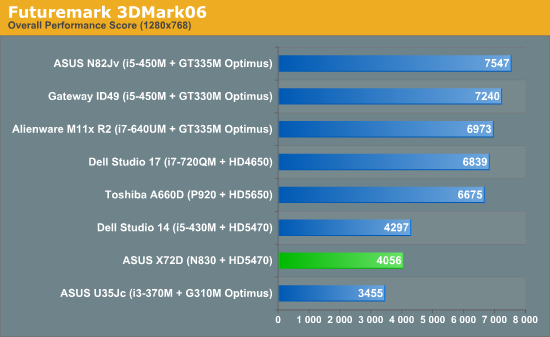
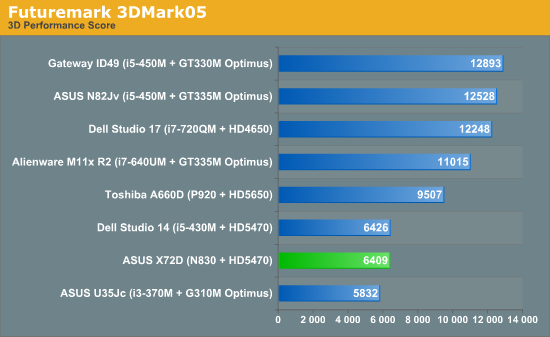

In some cases, the 5470 seems to be limited by the Phenom II; the Studio 14 has a slower core clock on the GPU but a much faster processor, making most of the results a wash.
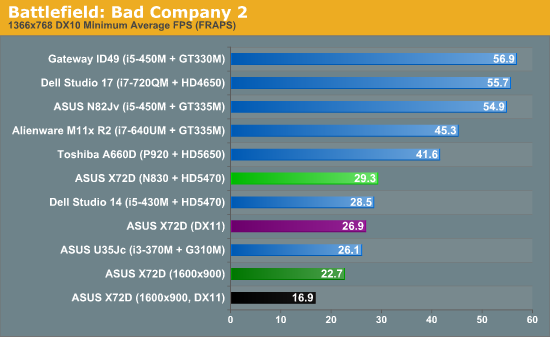
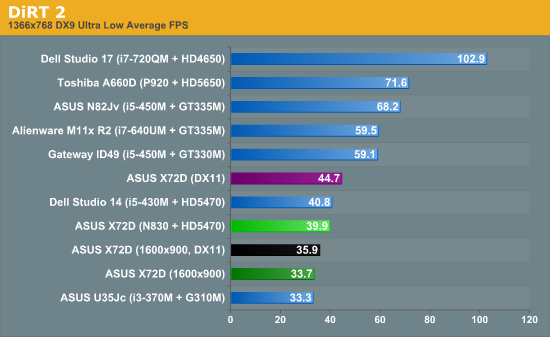
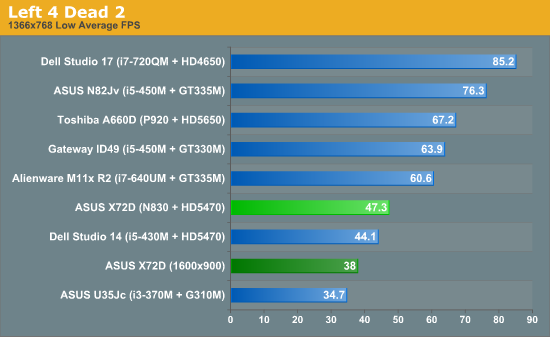

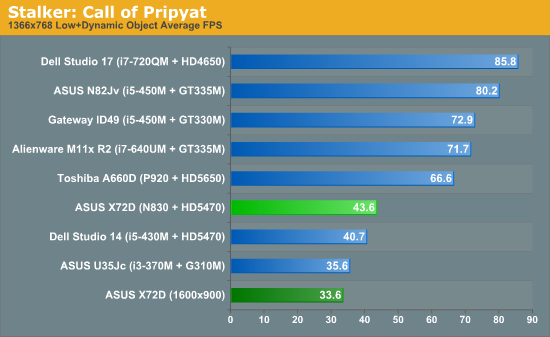
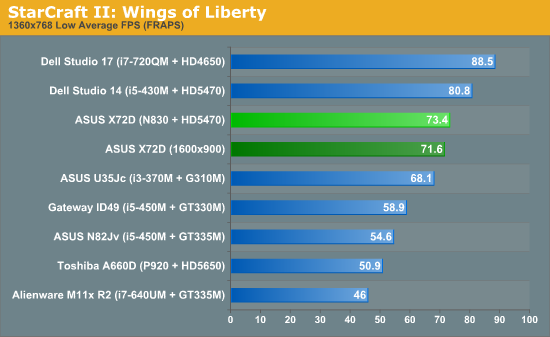
Well, the 5470 can game, sort of. StarCraft II generally cedes victory to the Radeons at Low assuming no major CPU bottlenecks (like, say, a 1.6 GHz quad core Phenom II), so no surprises there. But keep in mind these settings are pretty much as low as these games can go, and frankly StarCraft II looks horrible at these settings—imagine the original game, in 3D, but with textures from 10 years back and you get the idea. The Mobility Radeon HD 5470 is still miles away from catching up with mainstream class GPUs, though. It picks on the GeForce G 310M pretty liberally, but that's like winning a race with a three-legged horse because the other competitors are dead.
Which raises the same complaints we had when we reviewed the U35Jc and the GeForce G 310M: entry-level GPUs are terrible, offering little value over integrated options. On the X72D, this problem is made more egregious by three things: first, as I've mentioned before, the Radeon HD 5470 is a joke on any platform. Our next generation part has the same number of shaders as its predecessor, and worse, because of DirectX 11 support those shaders are actually slower. So in practice, the difference between the 5470 and last generation's Mobility Radeon HD 4570 is like night and night. But wait, there's more!
The X72D is using AMD's RS880 chipset, which means it already had perfectly serviceable integrated graphics to begin with in the form of the Radeon HD 4290. Since the 5470 just doesn't offer enough gaming performance to merit its inclusion over the IGP (let alone its existence), it's difficult to figure out why it's even here. The 5470 isn't capable of better Blu-ray playback than the 4290—okay, it can bitstream HD audio, but otherwise they're equal—so that's no justification either.
And finally, this is a 17" notebook. In a chassis this size, there's just no reason not to include a Mobility Radeon HD 5650, especially when Acer is happy to offer one in a competing notebook at just $699. The Acer Aspire AS7551G may have one of the worst keyboards on the market and be missing a Blu-ray drive, but in terms of gaming performance it's a far better deal. If Acer can hit that price point, there's no reason ASUS couldn't put a 5650 in the X72D.










37 Comments
View All Comments
pattycake0147 - Monday, October 25, 2010 - link
FYIThere is a pricing row on the first page table, but the price isn't listed.
OneArmedScissorB - Monday, October 25, 2010 - link
"There's still a major stumbling block for AMD in terms of power consumption, though: an AMD-based notebook has to power both a northbridge and a southbridge, while most of this functionality is either handled by integrated hardware in Intel's mobile processors or by the single power friendly HM55/PM55 chip."Considering that there is a separate, 45nm chip fitting the exact definition of the traditional laptop northbridge chip in the dual-core Core iX CPU package, and that the Core 2 platform, with its multiple "inefficient" and "obsolete" chips still seems to be untouchable in battery life, that statement is riding a fine line between silliness and misinformation.
It doesn't surprise me one bit that AMD's laptops tend to use a bit more power. That's just what happens with a more complex GPU and more CPU cores. Why that would be more dependent on nearly identical northbridge and southbridge functionality is beyond me.
mino - Monday, October 25, 2010 - link
Seconded.JarredWalton - Wednesday, October 27, 2010 - link
I've updated the text to make it clear that it's not just having an extra chip, but having three AMD chips (which have traditionally not been as power optimized) vs. two Intel chips is a real concern. The AMD CPUs have always used more power (at least post Pentium M), and I don't think either the NB or SB is particularly power friendly. They're not horrible either, but having two chips doesn't do AMD any favors. Finally, toss in process tech and the result is less than ideal battery life.SteelCity1981 - Monday, October 25, 2010 - link
I really don't know why AMD calls these Phenom II's when they lack an L3 cache which puts it a lot closer to the Athlon II chips. It can get confusing and hard to tell each mobile cpu apart that AMD markets for advance users to tell apart let alone the avg pc user lol. Unlike their desktop chips line which is pretty cut and dry, their mobile chips on the other had are all over the place. You have the mobile Phenom II x4/x3/x2, the Athlon II X2/ Neo X2, the Turion II X2/ Neo X2 (which are basicly lower clocked Phenom II mobile cpu's now.) and the AMD single core V series that are all based on the same Champlain 45nm architecture.mino - Monday, October 25, 2010 - link
Same reason why Intel calls Lynnfield i7. Marketing BS.SteelCity1981 - Monday, October 25, 2010 - link
Yeah but in the mobile sector Intel's chips are a lot more clearer then AMD's to understand. Core i7 highend, Core i5 mainstream, Core i3 budget,vol7ron - Monday, October 25, 2010 - link
It's sort of like Back-to-the-Future III, it's really less like B2F II and more like Feival Goes West.GullLars - Monday, October 25, 2010 - link
Since this is a laptop offering SATA 6Gbps, i strongly suggest you run a bench round with C300 128/256GB in it.It would also be nice to see the PCmark scores of that compared to the original configuration and the competition.
Storage performance can be a real problem in laptops, so this could be a key selling point, at least for the version K72DR that does not include the mostly pointless price addition of a BD player.
ssj4Gogeta - Monday, October 25, 2010 - link
"Processor AMD Phenom II N830(3x2.1GHz, 45nm, 1.5MB L2, 35W)"
Why do you state it as 3 times 2.1GHz? The frequencies of the cores don't add up. 3 cores don't even mean linear scaling vs. 1 core. So technically it's incorrect.